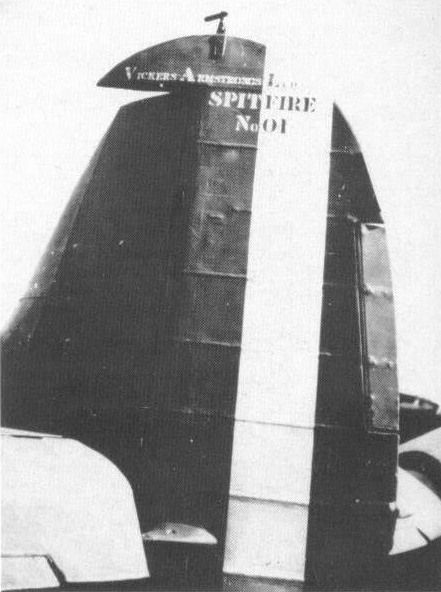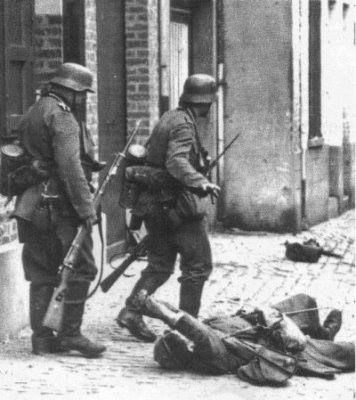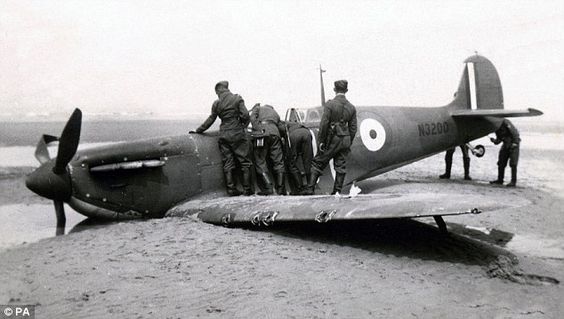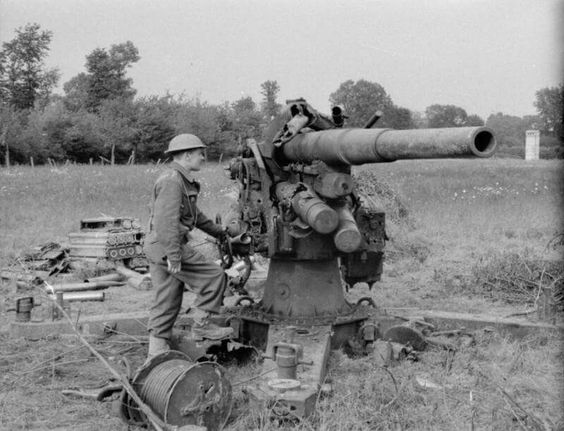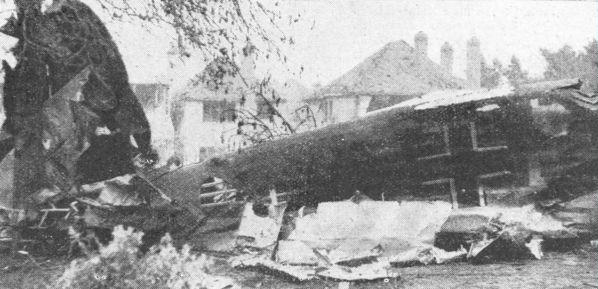Saturday 8 June 1940
 |
| Scharnhorst opening fire on HMS Glorious on 8 June 1940. |
There is the added element that the Admiralty's papers on the incident remain locked up under the infamous "100-year rule," which could be waived - but, for so embarrassing, nay humiliating an incident, will not be. The papers will remain secret until 2040, by which time pretty much everyone but people like us will have long forgotten the incident - as they largely have already.
Operation Juno is one in a succession of German naval sorties that sail up the Norwegian coast. With many of the other operations, the objective was to break out into the Atlantic by circling around Great Britain; however, the objective of Operation Juno is to aid General Dietl's mountain troops trapped against the Swedish border east of Narvik. Adolf Hitler is obsessed with Dietl's predicament, and the idea is to pound the Allied base at Harstad to prevent further Allied reinforcements.
Since battleships Bismarck and Tirpitz are not ready, the Kriegsmarine sends its most reliable pocket battleships (really heavy cruisers): Scharnhorst and Gneisenau. They are accompanied by heavy cruiser Admiral Hipper and the destroyers Z20 Karl Galster, Z10 Hans Lody, Z15 Erich Steinbrinck, and Z7 Hermann Schoemann. Any surface sortie is dangerous, but the Germans have gotten away with it previously and this is a rare chance to use the surface ships to achieve a strategic purpose, as opposed to mere commerce raiding as with the Admiral Graf Spee.
Early on, Luftwaffe reconnaissance reports that the Allies are evacuating from Harstad. This robs Operation Juno of its strategic impact. Admiral Wilhelm Marschall aboard the Gneisenau, however, decides on his own initiative not to waste the opportunity - Kriegsmarine surface sorties are rare opportunities for aggressive commanders and not to be wasted. He turns the mission into a pure naval raid, disregarding his orders to avoid enemy action.
He has plenty of opportunities. With the Allies pulling out of Narvik, the sea lanes between there and Scapa Flow are crowded with Royal Navy vessels. First, heavy cruiser Admiral Hipper comes upon largely empty troopship HMS Orama, tanker Oil Pioneer and minesweeping trawler Juniper - and dispatches all three. The Orama is a modern (1924) Orient Line passenger liner which had been impressed into Royal Navy service. She goes to the bottom about 300 miles west of Narvik, but thankfully she is not full of troops and only 19 men lose their lives. The Admiral Hipper takes aboard 280 prisoners. To the Admiral Hipper's credit, there is an accompanying hospital ship, the Atlantis, which has obeyed the rules of war by not radioing its position - and the Admiral Hipper lets her go. After this, Admiral Marschall detaches the Admiral Hipper with a couple of destroyers to make port in Trondheim.
The sinking of the Orama and the others, however, is just the appetizer. Royal Navy aircraft carrier HMS Glorious ((77) Captain Guy D’Oyly-Hughes) leaves Harstad at 03:00 bound for Scapa Flow, accompanied by destroyers HMS Arden and Acasta. Glorious is serving as a transport vessel and has onboard all of the Gladiators and Hawker Hurricanes from Bardufoss and a smaller-than-usual complement of its own planes. The Hurricanes are not equipped for naval landings and their pilots are not trained in operating from carriers, so the planes just get in the way. In fact, D'Oyly-Hughes all stowed all of the planes below decks for some reason despite being in a war zone. This makes aircraft carrier Glorious vulnerable, and D'Oyly-Hughes requests, and receives, permission, to return to Scapa Flow independently at full speed. Much is made of this decision in the critical commentaries on the incident, but during World War II it is a well-regarded theory that the best protection for any ship is speed.
Accompanied by the destroyers, Glorious heads south. D'Oyly-Hughes made some critical mistakes: he failed to keep any aircraft in the air as a constant Combat Air Patrol, and he failed to post any lookouts in his crow's nest. The former error is somewhat understandable because he only had nine Sea Gladiators and five Swordfish on board (in addition to the land planes); failure to post lookouts, though, smacks of incompetence.
The Scharnhorst and the Gneisenau spot HMS Glorious and her escorts about 180-200 miles west of Norway at around 16:30. Admiral Marschall opens fire at maximum range and incredibly scores a hit on his third salvo with his 11-inch shells at 24 km. Hits at such a range ar devastating because the shells come down almost vertically and plunge through the decks, "plunging fire" is the favorite tactic of the "Battleship Admirals." This damage, only 6 minutes into the encounter, prevents the Glorious from launching any aircraft and essentially seals her fate.
The two Royal Navy destroyers, Ardent and Acasta, lay smoke and closed on the two pocket battleships. This is a desperate maneuver, and everyone in the Royal Navy has the memory of HMS Glowworm in the back of their minds. The suicide mission pays off in part when one of Acasta's torpedoes (it launches four) hits the Scharnhorst, causing serious damage and killing 50 German sailors. The destroyers' 120 mm guns, however, cause little damage on the larger German ships, and both Ardent (151 dead, 2 survivors) and Acasta (161 dead, 1 survivor) soon are on the bottom (the former at 17:50, the latter at 19:20).
 |
| As seen from the Scharnhorst, the Gneisenau firing her main guns. |
Scharnhorst and Gneisenau then head for Trondheim themselves. They have proven once and for all that, under the right circumstances, the Kriegsmarine surface fleet can be absolutely devastating. The Scharnhorst is in bad shape, with flooding of 2,500 long tons and her after-turret out of action. She will require a trip back to Germany for repair. Meanwhile, with the German pocket battleships retiring, the final Royal Navy troop convoy from Narvik gets through to Scapa Flow un-noticed.
 |
| HMS Glorious sinking. |
General Rommel and his 7th Panzer Ghost Division, along with the accompanying 5th Panzer Division, reach the Seine at Rouen. The 5th Panzer sends troops into the city. French 10th Army is in tatters. British 51st (Highland) Division on the coast is bypassed and its lines of communication cut.
Back on the Somme, XIV Panzer Corps breaks through the French artillery block at Amiens. French 7th Army at Péronne continues to hold 16th Panzer Division to a standstill, which must be extremely frustrating as they watch the breakthrough to Rouen. It is a typical hedgehog campaign, with some strong points holding, but others failing and allowing strong breakthroughs.
European Air Operations: The air over the front is full of swirling planes. Captain Wuillame of Groupe de Chasse (Fighter Group) I/2 is flying a Morane-Saulnier MS406. He claims three Bf 109E fighters in only 15 seconds over the Somme sector. Despite this victory, the lack of adequate French air cover is becoming a major problem for the Allied ground forces.
French bombers attack factories near Berlin before dawn.
Battle of the Atlantic: British freighter Hardingham hits a mine and sinks in the English Channel.
Italian warships lay more mines in the Mediterranean.
Convoy HG 33 departs from Gibraltar, Convoy SL 35 departs from Freetown.
German Military: German casualties are hitting 5,000/day., much higher than in previous campaigns - but France is the Big Enchilada.
Norway: The Allies conclude their evacuation of troops from Narvik and Harstad, taking off a final tranche of 24, 000 men. Before departing, they render the port facilities useless to the Germans until repaired - which they soon are.
The Norwegian troops opposing General Dietl near the border pull out and disguise their departure by leaving dummies along the line. The German mountain troops soon realize what is happening, and occupy Narvik again. There are still Norwegian troops in the area, but they have no Allied support whatsoever and are out-matched by the Wehrmacht troops.
Anglo/French Relations: Prime Minister Reynaud sends his deputy General Charles de Gaulle to England to confer with British Prime Minister Winston Churchill.
Australian Government: Sir Keith Murdoch, a newspaper magnate, becomes the Australian Minister of Information.
Science: Edwin M. McMillan and Philip H. Abelson at the University of California at Berkeley reveal the discovery of element 93, neptunium (symbol Np), a decay product of uranium-239.
League of Nations: Increasingly irrelevant in a world at war, the League of Nations lays off 75% of its staff.
French Homefront: The rumble of distant gunfire becomes noticeable in Paris, though the government reassures the populace that is is just nearby anti-aircraft artillery.
British Homefront: The US State Department issues an advisory for US citizens in England and Ireland to depart next week on the liner Washington in order to avoid a possible German invasion.
There is a media blackout in the UK. George Orwell writes, "In the midst of a fearful battle, one has the impression there's no news." There is indeed news, but none of it is good for the Allies.
Future History: Nancy Sinatra is born in Jersey City, New Jersey. She becomes famous in the 1960s for such hits as "These Boots Are Made For Walkin'" and "You Only Live Twice," along with the No. 1 duet with her dad Frank, "Something Stupid."
 |
| Nancy Sinatra in the 1960s. |
June 1, 1940: Devastation at Dunkirk
June 2, 1940: Hitler Visits France
June 3, 1940: Operation Paula
June 4, 1940: We Shall Fight
June 5, 1940: Fall Rot
June 6, 1940: Weygand Line Crumbling
June 7, 1940: British Evacuating Narvik
June 8, 1940: Operation Juno
June 9, 1940: Norway Capitulates
June 10, 1940: Mussolini Throws Down
June 11, 1940: Paris an Open City
June 12, 1940: Rommel at St. Valery
June 13, 1940: France Goes Alone
June 14, 1940: Paris Falls
June 15, 1940: Soviets Scoop Up Lithuania
June 16, 1940: Enter Pétain
June 17, 1940: The Lancastria Sinks
June 18, 1940: A Day of Leaders
June 19, 1940: U-boats Run Wild
June 20, 1940: Pétain Wilts
June 21, 1940: Hitler's Happiest Day
June 22, 1940: France Is Done
June 23, 1940: Hitler in Paris
June 24, 1940: Six Million Jews
June 25, 1940: German Celebrations
June 26, 1940: USSR Being Belligerent
June 27, 1940: Malta in Peril
June 28, 1940: Channel Islands Bombed
June 29, 1940: Gandhi Insists on Independence
June 30, 1940: Channel Islands Occupied
2020

